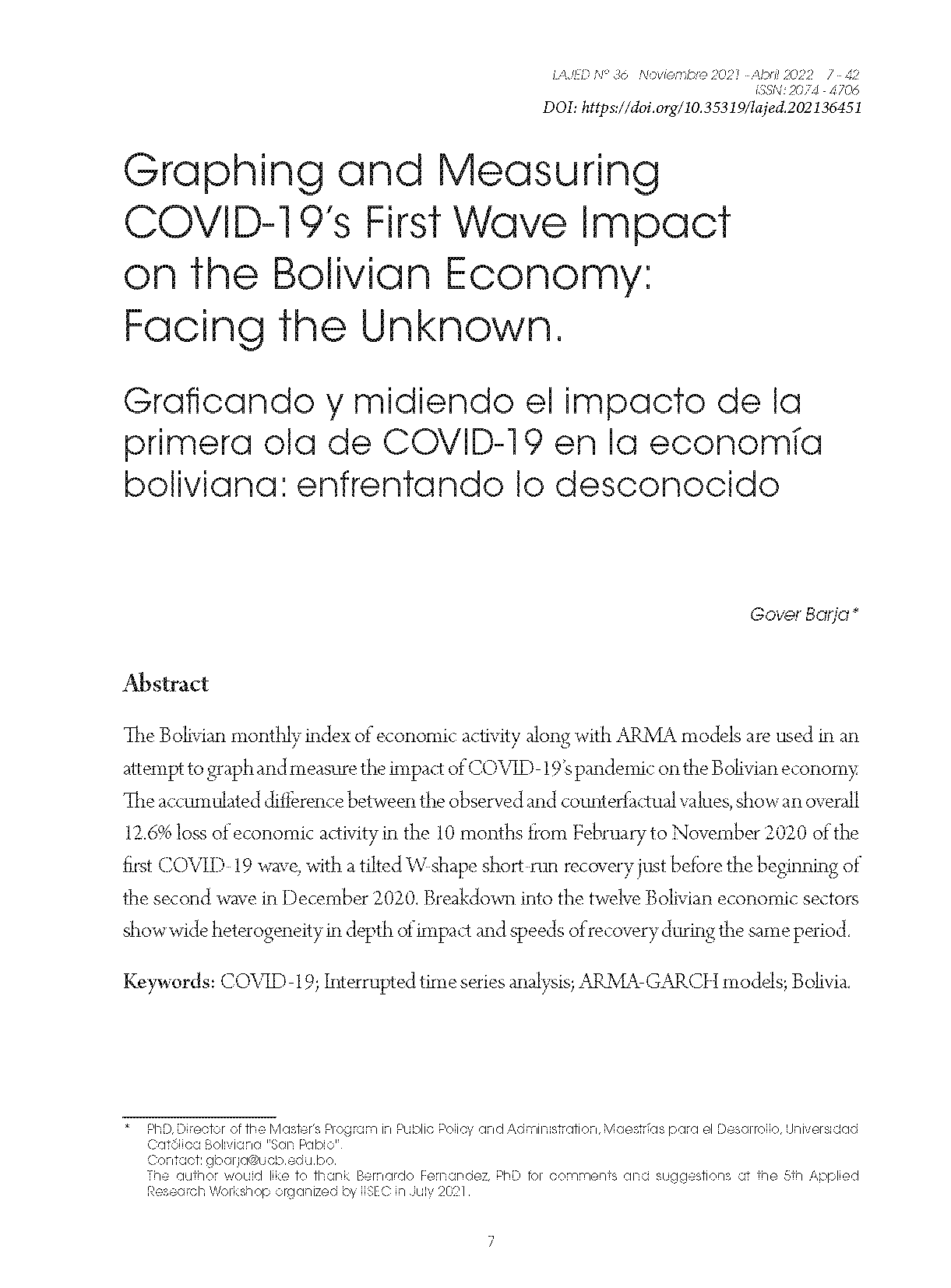Graphing and Measuring COVID-19’s First Wave Impact on the Bolivian Economy: Facing the Unknown.
DOI:
https://doi.org/10.35319/lajed.202136451Keywords:
COVID-19, Interrupted time series analysis, ARMA-GARCH models, BoliviaAbstract
The Bolivian monthly index of economic activity along with ARMA models are used in an attempt to graph and measure the impact of COVID-19’s pandemic on the Bolivian economy. The accumulated difference between the observed and counterfactual values, show an overall 12.6% loss of economic activity in the 10 months from February to November 2020 of the first COVID-19 wave, with a tilted W-shape short-run recovery just before the beginning of the second wave in December 2020. Breakdown into the twelve Bolivian economic sectors show wide heterogeneity in depth of impact and speeds of recovery during the same period.
Downloads
References
Bollerslev, T. (1986). Generalized autoregressive conditional heteroscedasticity. Journal of Econometrics, (31), 307-327.
Box, G.E.P. and Jenkins, G.M. (1970). Time series analysis, forecasting and control. San Fransisco: Holden-Day.
Box, G.E.P., Jenkins, G.M. and Reinsel, G.C. (1994). Time series analysis, forecasting and control (3rd ed.). Prentice-Hall.
COVID-19 data (2020). Bolivia Segura, Estado Plurinacional de Bolivia. https://www.unidoscontraelcovid.gob.bo/index.php/category/reportes/
Craig, P., Cooper, C., Gunnell, D., Haw, S., Lawson, K., Macintyre, S., Ogilvie, D., Petticrew, M., Reeves, B., Sutton, M. and Thompson, S. (2012). Using natural experiments to evaluate population health interventions: new Medical Research Council guidance. Journal of Epidemiology & Community Health,66(12). 1182-1186. http://dx.doi.org/10.1136/jech-2011-200375
Engle, R.F. (1982). Autoregressive conditional heteroscedasticity with estimates of the variance of United Kingdom inflation. Econometrica, 50(4), 987-1007.
Hudson, J., Fielding, S. and Ramsay, C. (2019). Methodology and reporting characteristics of studies using interrupted time series design in healthcare. BMC Medical Research Methodology, 19. https://bmcmedresmethodol.biomedcentral.com/articles/10.1186/s12874-019-0777-x
IGAE data (2008-2020). Instituto Nacional de Estadística (INE). La Paz. https://www.ine.gob.bo/index.php/estadisticas-economicas/indice-global-de-actividad-economicaigae/
Schaffer, A.L., Dobbins, T.A. and Pearson, S.A. (2021). Interrupted time series using autoregressive integrated moving average (ARIMA) models: a guide for evaluating large-scale health interventions. BMC Medical Research Methodology, 21. https://bmcmedresmethodol.biomedcentral.com/track/pdf/10.1186/s12874-021-01235-8.pdf
Williams, J.C. (2017). The perennial problem of predicting potential. Federal Reserve Bank of San Francisco Economic Letter 2017-32. https://www.frbsf.org/economicresearch/files/el2017-32.pdf






